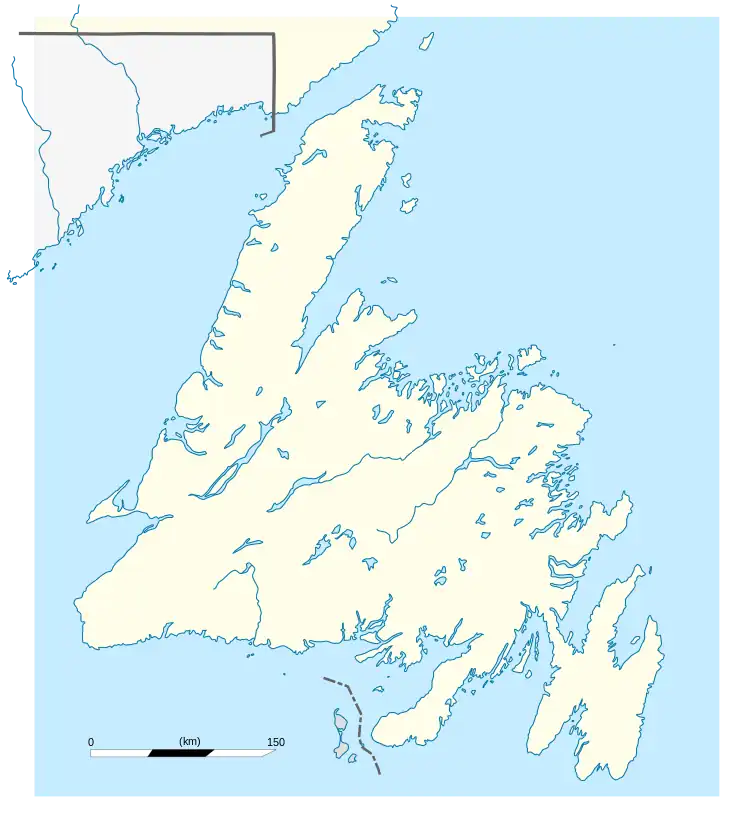St. Shott's
St. Shott's is the southernmost town in the Canadian province of Newfoundland and Labrador. A popular claim the town is associated with is having the most fog. In the Canada 2021 Census, the town had a population of 55.
St. Shott's | |
|---|---|
Town | |
 St. Shott's Location of St. Shott's in Newfoundland | |
| Coordinates: 46°37′58″N 53°35′14″W | |
| Country | Canada |
| Province | Newfoundland and Labrador |
| Area | |
| • Land | 1.14 km2 (0.44 sq mi) |
| Population (2021) | |
| • Total | 55 |
| Time zone | UTC-3:30 (Newfoundland Time) |
| • Summer (DST) | UTC-2:30 (Newfoundland Daylight) |
| Area code | 709 |
| Highways | |
St. Shott's is accessible by road via St. Shott's Road (Route 10–52), connecting the town with Route 10 (Irish Loop Drive).
Demographics
In the 2021 Census of Population conducted by Statistics Canada, St. Shott's had a population of 55 living in 34 of its 50 total private dwellings, a change of -16.7% from its 2016 population of 66.[1] With a land area of 1.07 km2 (0.41 sq mi), it had a population density of 51.4/km2 (133.1/sq mi) in 2021.[2]
Shipwrecks
The town has had numerous shipwrecks occur in the waters off its coast over the last five centuries. The Dutch steamship "Anton van Driel" ran aground on a foggy day while en route from Nova Scotia to Rotterdam in the Netherlands. Of the 30 individuals on board, only three survived drowning after being rescued by a tugboat, and only one body was ever recovered, that of a man named Hajo de Jonge.
Climate
St. Shott's has an extremely water moderated subarctic climate (Dfc). At sea level, this climate is the second closest to the equator in the Northern Hemisphere, behind the Kuril Islands. Due to the moderating effect of the Atlantic Ocean and Labrador Current, extreme maxima and minima are very limited. Summers are almost nonexistent, with temperatures above 70 °F (21 °C) being very rare. Winters are very mild by Canadian standards but can last half of the year or more some years. Any snow that falls is usually melted by falling rain, and ends up either completely melted or as leftover slush. Days with highs above 68 °F (20 °C) average 1.9, and with highs below 32 °F (0 °C) average 57.8. The highest record snowfall was 10.2 inches (26 cm) and occurred on January 26, 1987. The highest recorded snow depth was 64.6 inches (164 cm) and occurred on March 14, 1987. Precipitation is very heavy year round at nearly 60 inches (150 cm).[3]
| Climate data for St. Shott's | |||||||||||||
|---|---|---|---|---|---|---|---|---|---|---|---|---|---|
| Month | Jan | Feb | Mar | Apr | May | Jun | Jul | Aug | Sep | Oct | Nov | Dec | Year |
| Record high °F (°C) | 49.1 (9.5) |
48.2 (9.0) |
54.5 (12.5) |
63.5 (17.5) |
63.5 (17.5) |
69.8 (21.0) |
75.2 (24.0) |
74.3 (23.5) |
73.4 (23.0) |
66.9 (19.4) |
57.2 (14.0) |
52.7 (11.5) |
75.2 (24.0) |
| Average high °F (°C) | 32.2 (0.1) |
30.6 (−0.8) |
33.8 (1.0) |
39.9 (4.4) |
46 (8) |
52.3 (11.3) |
58.8 (14.9) |
62.2 (16.8) |
58.5 (14.7) |
51.1 (10.6) |
43.7 (6.5) |
36.1 (2.3) |
45.4 (7.5) |
| Daily mean °F (°C) | 26.4 (−3.1) |
25 (−4) |
28.6 (−1.9) |
35.1 (1.7) |
40.6 (4.8) |
46.8 (8.2) |
54 (12) |
57.2 (14.0) |
53.1 (11.7) |
45.7 (7.6) |
38.7 (3.7) |
30.7 (−0.7) |
40.2 (4.5) |
| Average low °F (°C) | 20.8 (−6.2) |
19.4 (−7.0) |
23.5 (−4.7) |
30 (−1) |
35.1 (1.7) |
40.6 (4.8) |
48.9 (9.4) |
52 (11) |
47.8 (8.8) |
40.3 (4.6) |
33.6 (0.9) |
25.5 (−3.6) |
34.8 (1.6) |
| Record low °F (°C) | −3.1 (−19.5) |
−9.9 (−23.3) |
−14.8 (−26.0) |
12.2 (−11.0) |
17.6 (−8.0) |
27.5 (−2.5) |
32 (0) |
32 (0) |
28 (−2) |
17.6 (−8.0) |
10.4 (−12.0) |
−0.9 (−18.3) |
−14.8 (−26.0) |
| Average precipitation inches (mm) | 5.59 (142) |
4.09 (104) |
4.98 (126) |
4.47 (114) |
4.37 (111) |
5.08 (129) |
4.83 (123) |
4.39 (112) |
5.48 (139) |
5.67 (144) |
5.42 (138) |
5.19 (132) |
59.56 (1,514) |
| Average snowfall inches (cm) | 13.4 (34) |
12.5 (32) |
8.3 (21) |
1.8 (4.6) |
0.3 (0.76) |
0 (0) |
0 (0) |
0 (0) |
0 (0) |
trace | 1.2 (3.0) |
6.4 (16) |
43.9 (111.36) |
References
- "St. Shott's Census Profile".
- "Population and dwelling counts: Canada, provinces and territories, census divisions and census subdivisions (municipalities), Newfoundland and Labrador". Statistics Canada. February 9, 2022. Retrieved March 15, 2022.
- "St Shotts New Foundland & Labrador Canada Climate Graphs, with Monthly Temperatures, Precipitation, & Snowfall for St Shotts". www.eldoradoweather.com. Retrieved 2020-08-10.
